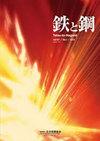Changes in the Heterogeneous Deformation Structure and Texture with Cold Rolling Reduction in {110}<110> Oriented Coarse Grained 3% Silicon Steel
IF 0.5
4区 材料科学
Q4 METALLURGY & METALLURGICAL ENGINEERING
Tetsu To Hagane-journal of The Iron and Steel Institute of Japan
Pub Date : 2023-10-01
DOI:10.2355/tetsutohagane.tetsu-2023-037
引用次数: 0
Abstract
We systematically investigated changes in crystal orientation due to the cold rolling of a {110}<110> single crystal, which had not been researched to date, in a reduction range of 10–70%. The results allowed for a classification of the changes into the following three reduction cases. The first was a 10–20% reduction. For this reduction, there was almost no change in the matrix orientation, and a shear band slightly appeared near the surface layer. The second was a 30–50% reduction, at which many shear bands were introduced, and the crystal orientation inside the shear bands was rotated from the initial {110}<110> orientation to the {100}<001> orientation around the TD axis. There are cells in the shear band. And {100}<001> orientation cells are considered having lower strain than around cells to having lower GAM. Additionally, the {111}<211> orientation was also confirmed in a small area that was thought to be surrounded by shear bands. The third was a 60–70% reduction, at which the matrix rotated to {111}<110>, but there were some areas with a {111}<211> orientation. Furthermore, the shear bands increased with increasing reduction, and more inner orientations were observed for {111}<211> than for {100}<001>. {111}<211> bands and {100}<001> bands are considered different origins to change discontinuously.{110}<110>冷轧压下非均质变形组织和织构的变化取向粗晶3%硅钢
我们系统地研究了{110}单晶冷轧后晶体取向的变化,这是迄今为止尚未研究过的,在10-70%的还原范围内。结果允许将变化分类为以下三种减少情况。第一个是减少10-20%。在此还原过程中,基体取向几乎没有变化,在表层附近出现了轻微的剪切带。第二次是30-50%的还原,此时引入了许多剪切带,剪切带内的晶体取向围绕TD轴从最初的{110}取向旋转到{100}取向。剪切带中有细胞。{100}取向细胞被认为比周围细胞具有更低的应变,从而具有更低的GAM。此外,{111}取向也在一个被认为被剪切带包围的小区域得到证实。第三种是60-70%的减少,此时矩阵旋转到{111},但仍有一些区域具有{111}方向。剪切带随着还原度的增加而增加,{111}比{100}有更多的内取向。{111}带和{100}带被认为是不连续变化的不同起源。
本文章由计算机程序翻译,如有差异,请以英文原文为准。
求助全文
约1分钟内获得全文
求助全文
来源期刊
CiteScore
0.70
自引率
33.30%
发文量
74
审稿时长
6-12 weeks
期刊介绍:
The journal ISIJ International first appeared in 1961 under the title Tetsu-to-Hagané Overseas. The title was changed in 1966 to Transactions of The Iron and Steel Institute of Japan and again in 1989 to the current ISIJ International.
The journal provides an international medium for the publication of fundamental and technological aspects of the properties, structure, characterization and modeling, processing, fabrication, and environmental issues of iron and steel, along with related engineering materials.
Classification
I Fundamentals of High Temperature Processes
II Ironmaking
III Steelmaking
IV Casting and Solidification
V Instrumentation, Control, and System Engineering
VI Chemical and Physical Analysis
VII Forming Processing and Thermomechanical Treatment
VIII Welding and Joining
IX Surface Treatment and Corrosion
X Transformations and Microstructures
XI Mechanical Properties
XII Physical Properties
XIII New Materials and Processes
XIV Social and Environmental Engineering.

 求助内容:
求助内容: 应助结果提醒方式:
应助结果提醒方式:


